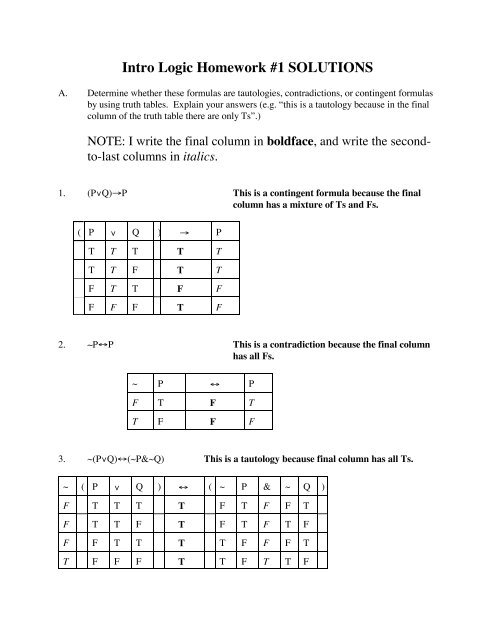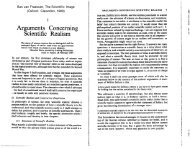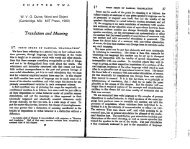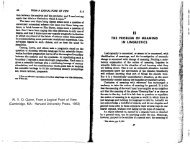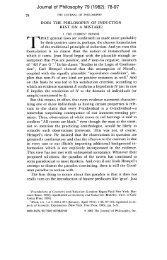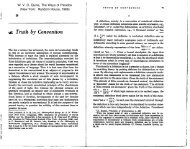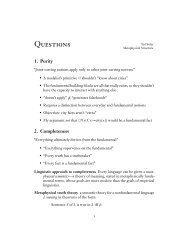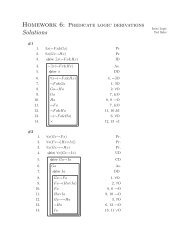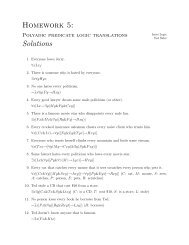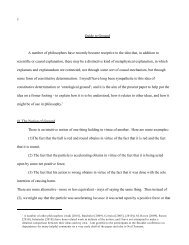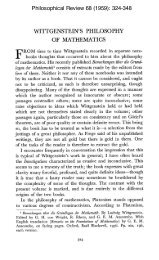Intro Logic Homework #1 SOLUTIONS - Ted Sider
Intro Logic Homework #1 SOLUTIONS - Ted Sider
Intro Logic Homework #1 SOLUTIONS - Ted Sider
Create successful ePaper yourself
Turn your PDF publications into a flip-book with our unique Google optimized e-Paper software.
<strong>Intro</strong> <strong>Logic</strong> <strong>Homework</strong> <strong>#1</strong> <strong>SOLUTIONS</strong><br />
A. Determine whether these formulas are tautologies, contradictions, or contingent formulas<br />
by using truth tables. Explain your answers (e.g. “this is a tautology because in the final<br />
column of the truth table there are only Ts”.)<br />
NOTE: I write the final column in boldface, and write the secondto-last<br />
columns in italics.<br />
1. (P!Q)"P This is a contingent formula because the final<br />
column has a mixture of Ts and Fs.<br />
( P ! Q ) " P<br />
T T T T T<br />
T T F T T<br />
F T T F F<br />
F F F T F<br />
2. #P$P This is a contradiction because the final column<br />
has all Fs.<br />
~ P $ P<br />
F T F T<br />
T F F F<br />
3. ~(P!Q)$(~P&~Q) This is a tautology because final column has all Ts.<br />
~ ( P ! Q ) $ ( ~ P & ~ Q )<br />
F T T T T F T F F T<br />
F T T F T F T F T F<br />
F F T T T T F F F T<br />
T F F F T T F T T F
4. ~(P"Q)"(~Q"~P) This is a contingent formula because the final column<br />
has a mixture of Ts and Fs.<br />
~ ( P " Q ) " ( ~ Q " ~ P )<br />
F T T T T F T T F T<br />
T T F F F T F F F T<br />
F F T T T F T T T F<br />
F F T F T T F T T F<br />
5. [(P$Q)&(P"R)] ! [~P"(Q&R)] This is a contingent formula because the final<br />
column contains a mixture of Ts and Fs.<br />
[ ( P $ Q ) & ( P " R ) ] ! [ ~ P " ( Q & R ) ]<br />
T T T T T T T T F T T T T T T<br />
T T T F T F F T F T T T T F F<br />
T F F F T T T T F T T T F F T<br />
T F F F T F F T F T T T F F F<br />
F F T F F T T T T F T T T T T<br />
F F T F F T F F T F F F T F F<br />
F T F T F T T T T F F F F F T<br />
F T F T F T F T T F F F F F F
6. ~[~P"(Q!R)] " [~P&Q] This is a contingent formula because the final column<br />
has a mix of Ts and Fs.<br />
~ [ ~ P " ( Q ! R ) ] " [ ~ P & Q ]<br />
F F T T T T T T F T F T<br />
F F T T T T F T F T F T<br />
F F T T F T T T F T F F<br />
F F T T F F F T F T F F<br />
F T F T T T T T T F T T<br />
F T F T T T F T T F T T<br />
F T F T F T T T T F F F<br />
T T F F F F F F T F F F<br />
B. In each case, for the two given formulas, % and &, use truth tables to answer the following<br />
questions (explain your answers): i) does % logically imply &? ii) does & logically imply<br />
%? iii) are % and & logically equivalent? You may use the short cuts discussed in class.<br />
7. %: P"R &: ~R"~P<br />
i) % does logically imply & because the formula “%"&” is a tautology:<br />
( P " R ) " ( ~ R " ~ P )<br />
T T T T F T T F T<br />
T F F T T F F F T<br />
F T T T F T T T F<br />
F T F T T F T T F<br />
ii) by reversing the two italicized columns we can see that “&"%” is a tautology;<br />
therefore & does logically imply %:
(~R"~P) " (P"R)<br />
T T T<br />
F T F<br />
T T T<br />
T T T<br />
iii) since % logically implies & and & logically implies %, % and & are logically<br />
equivalent.<br />
8. %: [(P&Q)!R] &: [P&(Q!R)]<br />
i) Since the formula “%"&” is not a tautology, % does not logically imply &:<br />
[ ( P & Q ) ! R ] " [ P & ( Q ! R ) ]<br />
T T T T T T T T T T T<br />
T T T T F T T T T T F<br />
T F F T T T T T F T T<br />
T F F F F T T F F F F<br />
F F T T T F F F T T T<br />
F F T F F T F F T T F<br />
F F F T T F F F F T T<br />
F F F F F T F F F F F
ii) by reversing the two italicized columns we can see that “&"%” is a tautology;<br />
therefore & does logically imply %:<br />
[P&(Q!R)] " [(P&Q)!R]<br />
T T T<br />
T T T<br />
T T T<br />
F T F<br />
F T T<br />
F T F<br />
F T T<br />
F T F<br />
iii) % and & are not logically equivalent, because % does not logically imply &;<br />
and for formulas to be logically equivalent, each must logically imply the<br />
other.<br />
9. %: Q"R &: R"Q<br />
i) % does not logically imply & because the formula %"& is not a tautology:<br />
( Q " R ) " ( R "<br />
T T T T T T T<br />
T F F T F T T<br />
F T T F T F F<br />
F T F T F T F<br />
Q )
ii) By reversing the italicized columns, we see that & does not logically imply % because<br />
the formula &"% is not a tautology:<br />
(R"Q) " (Q"R)<br />
T T T<br />
T F F<br />
F T T<br />
T T T<br />
iii) In order for % and & to be logically equivalent, each would have to logically imply<br />
the other. Since % didn’t logically imply & (nor for that matter did & logically imply<br />
%), these formulas are not logically equivalent.<br />
10. %: P$Q &: (P"Q) & (~P"~Q)<br />
i) Since %"& is a tautology, % logically implies &:<br />
[ P $ Q ] " [ ( P " Q ) & ( ~ P " ~ Q ) ]<br />
T T T T T T T T F T T F T<br />
T F F T T F F F F T T T F<br />
F F T T F T T F T F F F T<br />
F T F T F T F T T F T T F<br />
ii) Since &"% is a tautology, & logically implies %:<br />
[(P"Q) & (~P"~Q)] " [P$Q]<br />
T T T<br />
F T F<br />
F T F<br />
T T T<br />
iii) Since each logically implies the other, % and & are logically equivalent.
C. Use truth tables to decide whether the following arguments are valid or invalid; explain<br />
your answers. I'll write the arguments in the following form: Premise 1; Premise 2; ...<br />
Premise n / Conclusion<br />
NOTE: I’ll put the final columns of the premises and conclusion in<br />
boldface.<br />
11. P"~Q; ~Q"P / ~P$Q. The argument is valid because there is no case where the<br />
premises are all true while the conclusion is false.<br />
P " ~ Q ; ~ Q " P / ~ P $ Q<br />
case 1 T F F T F T T T F T F T<br />
case 2 T T T F T F T T F T T F<br />
case 3 F T F T F T T F T F T T<br />
case 4 F T T F T F F F T F F F<br />
12. P"Q; Q"R ; ~R / P This argument is invalid because in case 8, all the<br />
premises are true while the conclusion is false.<br />
P " Q ; Q " R ; ~ R / P<br />
case 1 T T T T T T F T T<br />
case 2 T T T T F F T F T<br />
case 3 T F F F T T F T T<br />
case 4 T F F F T F T F T<br />
case 5 F T T T T T F T F<br />
case 6 F T T T F F T F F<br />
case 7 F T F F T T F T F<br />
case 8 F T F F T F T F F
13. P!Q; P"R; Q"R / ~~R This argument is valid because there is no case in which<br />
all the premises are true while the conclusion is false.<br />
P ! Q ; P " R ; Q " R / ~ ~ R<br />
case 1 T T T T T T T T T T F T<br />
case 2 T T T T F F T F F F T F<br />
case 3 T T F T T T F T T T F T<br />
case 4 T T F T F F F T F F T F<br />
case 5 F T T F T T T T T T F T<br />
case 6 F T T F T F T F F F T F<br />
case 7 F F F F T T F T T T F T<br />
case 8 F F F F T F F T F F T F


